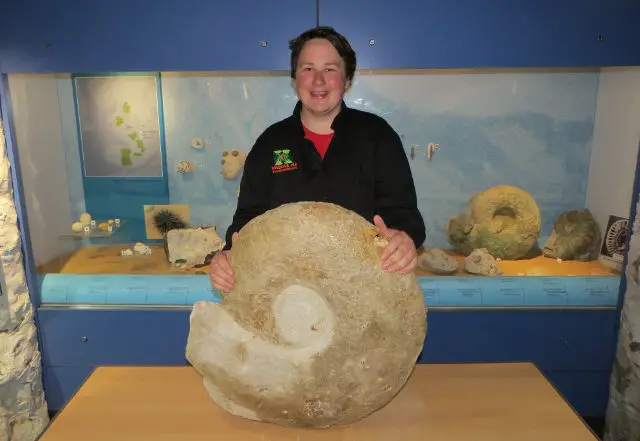This in from the council, in their own words. Ed
A large ammonite, which is also a complete specimen, was discovered near a cliff face by staff member Alex Peaker during a fossil walk.
The ammonite, identified as Austiniceras austeni, belongs to a group of ammonites known as Parapuzosia which are acknowledged to be the largest ammonites in the world.
Alex recalls:
“I was walking past some debris that had recently fallen from the cliff on a fossil hunting walk when I spotted the round characteristic shape of an ammonite. At first I didn’t want to get my hopes up as shapes can be misleading, however I took a closer look and saw the distinctive lines of an ammonite shell.
“Because it was below the cliff face, we sought permission to remove it from National Trust which is the landowner. It is lucky I spotted it when I did because it could have been washed away and lost to science.”
Weighs around two hundred kilos
Collecting the ammonite was a difficult task, with the fossil part of a large block of rock weighing in at around two hundred kilos. Undeterred, it took three members of staff eight hours to remove enough of the surrounding rock to lift the ammonite.
It was then transported using a beach buggy that has large inflatable tyres capable of carrying heavy weights over soft sand back to the museum.
Worked on in the lab
Since March, the ammonite has been worked on in the lab at Dinosaur Isle by Martin New who has carefully removed the remaining rock from the shell and given it a clean, finally revealing the fossil in its full complete form.
Alex added:
“It is very pleasing my find has been able to go on display at Dinosaur Isle Museum for all to enjoy.
“It just shows you never know when you may find something and it further reinforces the Isle of Wight’s reputation as one of the world’s best locations to find fossils.”
Dinosaur Isle is very grateful to the National Trust for the loan of this specimen and allowing it to go out on display at the museum.
Image: © Isle of Wight Council





